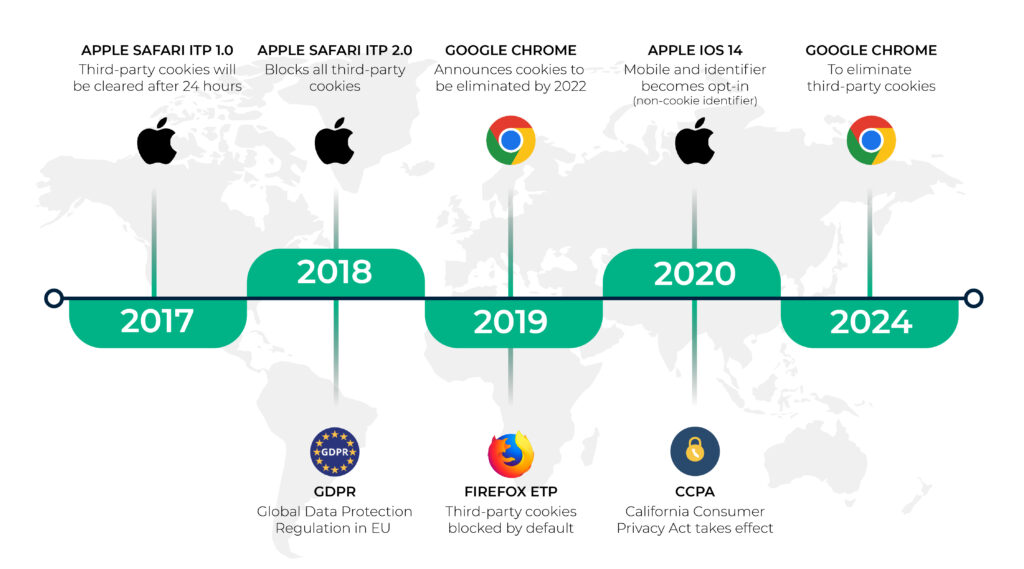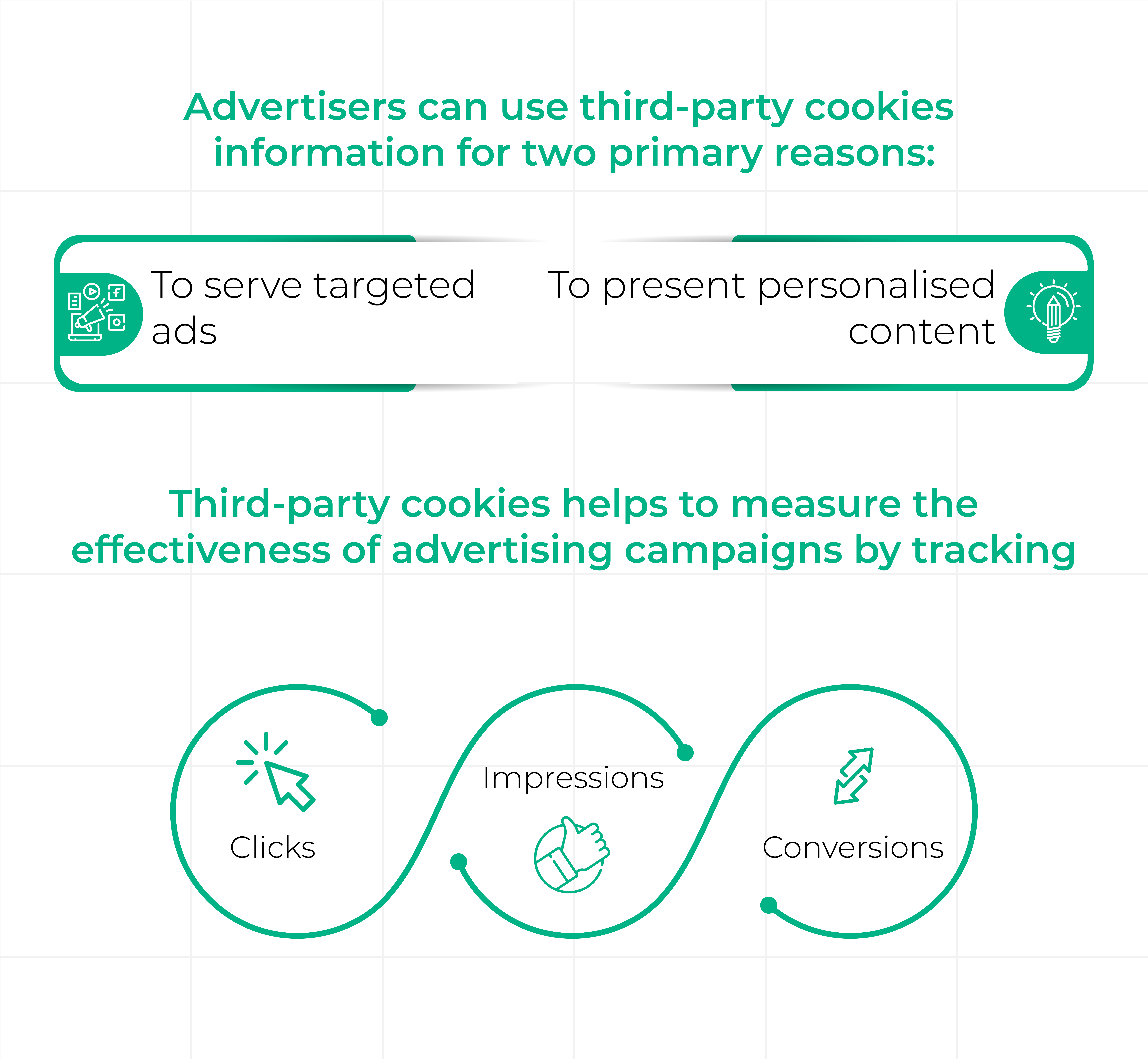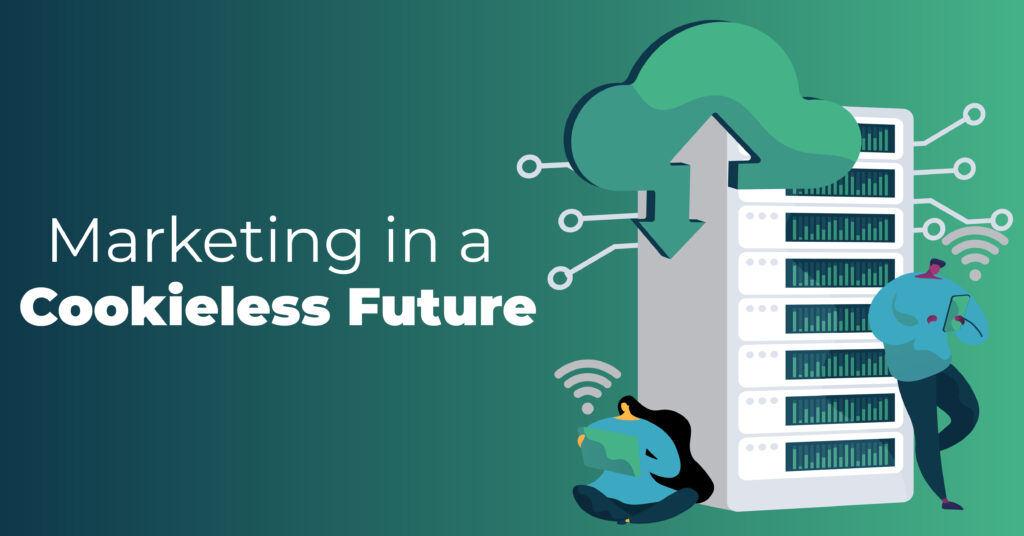For years, marketers have heavily relied on third-party cookies to target ads and personalise content! This helped the marketers run effective and high-conversion ads. And the effectiveness of their campaigns is what decides the performance and abilities of any marketer.
However, users raised concerns about their privacy and the usage of personal data by companies. This triggered the introduction of new regulations such as the CCPA (California Consumer Privacy Act) in the United States and the GDPR (General Data Protection Regulation) in Europe. Big tech companies have been taking the initiative to showcase that they are taking steps to safeguard user data and their privacy.

Browsers such as Firefox and Safari have already shut down third-party cookies, while Google has announced that Chrome will also deprecate third-party cookies at the end of 2023. This move will significantly impact the advertising industry, as Google Chrome currently has over 65.74% of the browser market share.
Businesses of all sizes, shapes and forms will be impacted and result in a re-think across the board of new marketing strategies in a cookieless world.
Below is more detail on the implications of a cookieless future for marketing and how ad tech companies are gearing up for it.
Understanding what third-party cookies do in marketing
Cookies from a domain other than the one the user is visiting are known as third-party cookies. They are used to collect data on user behaviour, such as the pages they visit, the products they buy, and the ads they click on.
Advertisers then use this information for two primary reasons:
- To serve targeted ads and
- To present personalised content.
This is what makes third-party cookies play a crucial role in measuring the effectiveness of advertising campaigns by allowing advertisers to track:
- Clicks,
- Impressions, and
- Conversions.

What does the end of third-party Cookies mean for businesses?
As it is understood today, without third-party cookies, it will be much harder for companies to track user behaviour and serve targeted ads.
But nothing is impossible in today’s world! As the world relies on innovation, businesses and marketers will embrace the change and bring forth new trends for tracking user behaviour and capturing their data with their consent. This will help businesses to create personalised experiences for the user and allow them to share their data with you at ease.
| Purpose of Third-Party Cookies | What won’t be possible in a cookieless world? |
| Advertising and Retargeting: Third-party cookies are often used to track users across the internet and serve them targeted advertisements based on their browsing history | targeting specific users with relevant ads, leading to effective advertising campaigns will become challenging |
| Analytics and User Tracking: Track user behaviour on their website, including pages users visit and how long they spend on each page. This data is then used to optimize the website and improve the user experience | Businesses will have a harder time understanding user behaviour on their website, leading to less effective optimization and potentially a poorer user experience. |
| Personalization: Used to personalize the user experience by remembering user preferences and past interactions with a website. It includes language preferences, product recommendations, and login information | There is a chance that businesses will struggle to provide tailored recommendations and targeted advertising to their users, which may result in a less engaging user experience and reduced sales performance. |
| Cross-Site Tracking: Track users across multiple websites, allowing businesses to build a more complete profile of each user. Thereby having a better understanding of user behaviour and preferences and delivering more targeted advertising. | Businesses would have limited visibility into user activity outside their website and would struggle to gather the necessary data to build accurate user profiles. |
How should businesses respond to the new change?
To prepare for a cookieless future, here are some ways to embrace the new change:
1. Focus on first-party data
First-party data is data a business collects directly from its customers through email addresses, website activity, and purchase history enablings businesses to create a complete view of their customers and personalise experiences and ads.
| Focus on first-party data | Examples |
| Collecting email addresses | An E-commerce store can use email addresses to send targeted product recommendations based on the customer’s purchase history. It also allows users to drop out of the email subscription with no questions asked. |
| Analysing website activity data | A news website can analyse user activity data to serve personalised news articles and ads based on the user’s interests. This process also helps in reducing the bounce rate, improving the overall UI/UX and converting the traffic to customers. |
| Using purchase history data | A beauty retailer can use purchase history data to suggest related products or offer a discount on a customer’s favourite product or allied competitors! |
2. Invest in tracking technologies
Explore alternative tracking technologies that supplement the loss of third-party cookies. Although, some turn to privacy-invasive techniques like device fingerprinting, better options are available like:
| Alternative Tracking Technology | Examples |
| Contextual targeting | A sports website might show sports equipment and apparel ads. This approach does not rely on user data and can deliver relevant ads without invading user privacy |
| Cohort-based targeting | This is a new approach to advertising that groups users based on their interests and behaviour rather than tracking them as individuals. This approach is being developed by Google’s Privacy Sandbox initiative to deliver personalised ads while maintaining user privacy. |
3. Working with partners
It is very obvious that with such an announcement, all the ad-tech players have found alternate solutions for capturing data, tracking conversions and embracing the cookieless future. Here are a few brands that offer alternative solutions:
Google Marketing Platform (GMP):
Google Analytics and Google Marketing Platform (GMP) offer robust support for 1st party audiences. With Google Analytics, you can create custom audiences based on user behaviour and attributes. For example, you can create an audience of users who have added items to their cart but did not complete a purchase. Then you can target them with a remarketing campaign to encourage them to complete their purchase.
GMP allows you to combine your 1st party audience data with Google’s vast audience data to create more precise targeting for your marketing campaigns. This can help you reach the right audience with the right message, increasing the effectiveness of your campaigns.
Google is committed to respecting user privacy and offers tools like Consent Mode, which allows you to adjust your measurement and advertising based on a user’s consent status. This helps you ensure that you are collecting and using data in a responsible and compliant manner.
The collaboration between digital teams at Adidas in the U.S. demonstrates the value of combining data from different sources to gain a deeper understanding of customers. By using Google Analytics and GMP together, brands can unlock insights that can help them optimize their marketing efforts and improve the customer experience.
Google’s Privacy Sandbox:
To cater to the growing user concern and privacy regulation, Google announced the elimination of third-party cookies. To ensure that all stakeholders find an alternative solution, the deadline has been extended now and again.
Google has shifted away from FLoC and towards Topics as its approach for interest-based advertising capabilities. The Topics API works by selecting topics that are associated with the user’s browsing history on a weekly basis, which is kept for three weeks. These topics are then shared with sites and advertisers. Hence, allowing for more relevant and personalised ads to be delivered to users without compromising their privacy.
Both initiatives are under a privacy sandbox, which is in the testing phase. Hence, Google will monitor the success of the tools and acceptance of the same in the market
Facebook Conversion API:
Facebook has introduced Conversion API to allow businesses to pass online and offline data directly to Facebook via a server-to-server integration, bypassing the need for third-party cookies completely. Thus allowing API passing both behaviour and outcomes, making it extremely useful in both targeting and optimizing campaigns.
Others
Many other ad tech players have introduced new tools that do not rely on third-party cookies. For example, Trade Desk has introduced Solimar and Unified ID 2.0. These tools use first-party data, contextual targeting, and unique identifiers, including email addresses, phone numbers, and IP addresses, to deliver personalised ads.
Other tools like MediaMath use first-party data, contextual targeting, and AI-driven insights and provide cross-device identification to deliver personalised ads.
4. Review and update privacy and cookie policies
Businesses need to update their privacy policies to inform users about the changes in data collection and data usage practices. Companies need to ensure that their policies are accurate, up to date, and concisely explain how user data is collected and used. Transparency and trust demonstrates its credibility to its prospects and customers.
5. Focus on user experience
A good user experience will be critical for a company to stand out in front of customers. Further, it also instils trust that allows them to share their personal information in exchange for a value add.
Personalisation is a key enabler to a better user experience. This can be enabled through:
- Personalised experiences such as personalised recommendations, personalised messaging, and personalised promotions that showcase value added for a customer
- Rewarding loyalty through rewards, discounts, samples and exclusive content
The Ending of 3P Cookies is the Beginning of Innovation!
Have you been relying too much on third-party cookies for your marketing?
A lot of businesses are adapting to the new ad tech landscape by defining and implementing new strategies and tactics. This is to evade falling behind their competitors. If you are looking toward long-term success, we recommend adopting a first-party marketing approach. For this you need to build a strong, reliable, and precise database of your customers that can drive future marketing campaigns effectively.
Further, first-party data substantially reduces the risk of privacy associated with third-party data and provides businesses with a new foundation for personalization and engagement.
Get in touch to discuss how you can better prepare for the road ahead!

